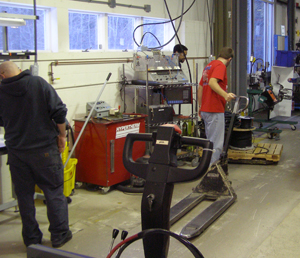ONLINE EXCLUSIVE: Hypertherm: Lean Leverage to Compete Globally from New Hampshire
Kevin Duggan
 |
|
| Associates rearrange equipment during an assembly cell re-layout for improved flow. |
Ten years ago, Hypertherm, a Hanover, NH, manufacturer, implemented “self-healing flow” as a critical step in its operational excellence journey. The result? The company fabricates 97 percent of its product on-site and ships 60 percent overseas. It surpassed pre-recession sales and never had a layoff in its 40-plus-year history.
Hypertherm is one of the world’s leading designers and manufacturers of advanced metal-cutting systems for use in a variety of industries, such as shipbuilding and automotive repair. Founders of the privately held company saw the need early on for each associate to be involved with business growth. In the mid-2000s, Hypertherm formalized this approach by creating a culture of operational excellence. These principles are instilled in all associates.
Employees eliminate waste, reduce cost, become more efficient, produce the products in flow to the customer and deliver the product to the customer with virtually no management. Hypertherm’s culture is not textbook “lean,” but rather one in which the associates understand their key role in delivering product to the customer and growing the business.
How Employees Improve Flow
From the shop floor to the receiving deck, Hypertherm established flow throughout all areas of its operations to build product at the rate of customer demand. But not just any flow. The company applied the concept of “self-healing” flow, in which associates can see the flow and take action when it starts to break down, before it impacts the customer.
Visual signals in fabrication areas eliminate the typical schedules, priority list, expedites, supervision and management to tell each associate what to work on next. “Thermometer boards” with green, yellow and red zones show associates at each process how flow is progressing. These signals authorize associates to perform work and let them know if a breakdown in flow has occurred — or is about to.
Associates can tell the difference between normal and abnormal flow. They use standard responses to correct breakdowns. Management becomes involved only infrequently. “What amazes me when I sit through our planning, relative to other firms I’ve been with, is how very little time we spend discussing operations-related things,” said Jim Miller, Hypertherm’s vice president of manufacturing, “Operations gets time; it’s not ignored. It’s not like we don’t want to talk about it. It’s that we don’t have to talk about it.”
Even in the office, flow is visual. A display in the customer service department shows the current incoming workload and “red zones” that designate when it becomes abnormal. When that happens, the associates in the flow follow a process to react accordingly. “The same words and concepts we use on the shop floor when we talk about flow and designing flow were used to create what we have in our offices today,” said Charlie Hackett, PhD, corporate improvement team leader.
Focus on Supply Chain
Hypertherm also turned its attention to the supply chain. It began by selecting suppliers that were only a few hours drive from Hanover. The company instituted a formal process for sharing knowledge with these suppliers and created a material delivery signal system to ensure that the right raw material for each day is delivered on time, every time. This signaling, which happens automatically from the production floor, authorizes the suppliers to perform work.
With an operation that consistently delivers product without a problem, an office that sees customer needs and reacts accordingly and a supply chain that is connected to Hypertherm’s changing customer demand, less management is needed to run the operation. Instead, management devotes added time and resources to being more competitive in the marketplace through the development of new products and technology. The company has more than 75 patents for its technology and continually explores new ideas — even during the recent recession. In 2009, when Hypertherm’s revenue was down 36 percent, the company’s research and development spending was up 20 percent.
Hypertherm’s focus on operational excellence pays off in results not many companies who manufacture in the United States can claim.
- While many American companies buy components from low-cost, international sources and sell their end products in the United States, 96 percent of Hypertherm’s supply chain is within 150 miles of Hanover. The company exports 30 percent of its locally produced product to Asia and another 30 percent to Europe.
- Hypertherm’s sales increased seven times from 2002 to 2008 and the company quickly recovered from the 2009 recession. Hypertherm is exceeding its 2008 sales levels and growing.
- Because associates not only build the product, but are also responsible for delivering it to the customer, the company understands how invaluable their knowledge is. In a 40-plus-year history, even at the height of the recession with a production workforce 20 percent larger than needed, the company has never had a layoff.
- As business growth outstripped the local labor market, Hypertherm built a training school offering college credits on its campus so it could train and hire associates to run its high-end machining, creating jobs instead of outsourcing them.
“Going forward, we’re going to keep pushing the envelope for how autonomous our operations can be in terms of not relying on management for their day-to-day functioning. We want to be focused on our customers and the needs of our business so we can continue to grow globally and challenge our associates,” Miller said.
Kevin Duggan is the founder of Institute for Operational Excellence.


